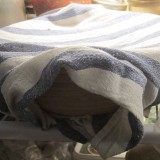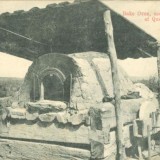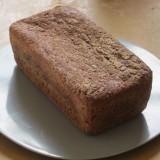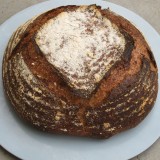Here’s the first in a series of Root Simple how-to videos. Look for them on the blog and, soon, on your mobile thingies. I started with a little edit on how to make a sourdough starter. And I take requests–if there’s a topic for a video you’d like to see just leave a comment.
Making a sourdough starter is as simple as mixing flour and water. There’s no need for all the crazy things I’ve heard suggested: adding potatoes, grapes, yogurt and certainly not commercial yeast. And the yeast that makes sourdough happen is on the flour itself in far greater quantities than in the air.
After following the simple steps I demonstrate in this video you’ll end up with a small amount of starter that you use to “inoculate” a larger batch of starter to use in a bread recipe. Keep your starter at room temperature and feed every day. Alternately, you can put it in the fridge if you don’t want to feed it all the time. When you want to wake it up, take it out of the fridge and feed for a day or two before you bake with it.
You’ll never go back to commercial yeast once you get used to the taste of bread made with a sourdough starter.
You can download a copy of this video here.




I watched your video. When you and the video say “feed it every day”, what does that mean? Is “feeding” it when you throw out half and add the Tsp each of water and flour?
Thanks! I’ve always wanted to do this but have never tried..
Yes, you’ve got it right– “feeding the starter” is giving it its daily flour and water – and throwing out a little so you don’t end up neck deep in starter. Good luck w. your bread! There will be more bread posts soon to help you.
I love u guys! Great video. Let mw know if u ever need a friend to come help shoot. It’d b great fun to help! Xo c
Hey Charlie, Would love to have your experienced help shooting some videos!
After several years of putting it off, I finally started my own sourdough starter! I’m having a bunch of trouble finding reliable recipes to use with it though. Either they vary a lot, don’t take a longer rising time into consideration, or want a split with normal yeast. Argh! I don’t suppose you guys could post some of the more interesting and practical recipes you use with your starter?
My favorite recipe comes out of the Tartine Bread cookbook. Lots of detailed instructions and it’s a pretty reliable recipe. Not much work either as it does not require kneading.
We also plan to do more bread-related videos, hopefully walking someone through a loaf from start to finish, so keep your eye out!
Well yes, there are plenty of well explained bread recipes. I was more thinking of alternates since I don’t go through a loaf of bread very quickly. Like biscuits or pancakes or other things that don’t readily come to mind?
I loved this video. I can’t wait to see what other videos you all come up with. The new design for the blog looks outstanding too.
I’m horrible at making sourdough. No matter what I do it never seems to come out right — either the starter doesn’t take (or I forget about it) or the loaf doesn’t rise sufficiently and is just a dense (though very tasty) brick. This video, I think, will really help with the starter. I like that it uses such a small amount of flour. I feel guilty throwing away half a cup of flour a day, as some recipes suggest.
I’d love to see some more videos on this subject. Going into the process of rising the bread (especially if it’s in a cold room, seems to go slower then) would really help.
Thanks so much guys!!
Lauren,
If you don’t have a digital scale already, that can really help get the ingredients consistent each time. As far as temperature during proofing, I have the same problem. Our kitchen swings between sweltering in the summer and drafty in the winter. Part of it is just sort of intuiting when you have to let it rise more or less. And I’ll get going on those videos!
Don’t know whether or not this is much too late to be helpful but here goes anyway.
1) If you live in a climate you can live in there’s really no such thing as too cold to rise. Dough will rise in a refrigerator it just takes more time. And that extra time equals extra flavor so it’s not a bad deal at all.
2) If you’re concerned about the cold and/or drafts the cavity of your microwave or oven make a fine insulated proofing box for dough. Just put a note on it that no one should turn them on while your dough is rising.
3) Dogs LOVE sourdough starter so the portion you eliminate makes a very tasty treat for them atop their normal kibble. The live yeast microrganisms also are happy, happy, happy in sewage so if you have your own septic system they will go right to work breaking down the contents if you put them down your drain. They’ll put off the time when you have to have your tanks drained.
I have a sourdough starter that is ~3 years old that I use every few weeks to make bread.
I don’t feed it! It sleeps in the fridge until I want to make bread. I don’t need to wake it up – I just add it the pre-ferment for 8 hours or so, and then save a couple of tablespoons before I make bread with it.
Sourdough is not a cat. The dormant yeast can live for months in the fridge without feeding, watering or petting. All this constant fussing at room temperature is just asking for contamination.
Thanks for [starting] to come to your senses 😉
I keep a batch in the frig and one on the counter at room temp. I alternate their use – usually bake every day or every other day. So I always have a back up pet to feed, pamper and generally coddle into bread dough. Now I’m experimenting with rye and rice flours with my starter to make bread for my gluten-averse loved-ones.
Speaking of backup, when you have a healthy starter going, smear several tablespoons of it on a piece of plastic wrap or a silpat or whatever. Leave it to dry.
When it’s thoroughly dry, crumple up the flexible base and the dried starter will crumble into powder. Put that in a jar and seal it well. I keep mine in the freezer.
If you need to restart your starter for any reason you can add that to the flour and water per the podcast and you’re back in business.
That’s a good tip! Healthy starter is amazingly resilient. I heard a story somewhere about a chef who had an ancient starter–one of those mothers which supposedly goes back generations. A disgruntled employee tossed it out into a back alley. When the chef discovered this, he scraped what he could off the pavement and was able to revive it.
Pingback: Whole Wheat Sourdough Starter Recipe | Root Simple
Pingback: How to Bake a Traditional German Rye Bread | Root Simple
I’ve resorted to cheating. For any other desperate individuals out there, here’s a recipe for making a more acidic sourdough starter:
http://www.thefreshloaf.com/node/10901/pineapple-juice-solution-part-2
http://forums.finecooking.com/print/node/63318?page=2&comment=737624
So I decided to try this. The first one I started I realized that I used self rising flour. I’m guessing that would be a no no. So I restarted with Bob’s Red Mill whole wheat flour since that’s all I had. I hope that’s ok. Problem is I don’t know what it’s supposed to smell like when it’s right or when it’s going sideways. So how do you tell?
Hi Jamie–you are correct not to use self-rising flour. As to what it should smell like–yeasty and slightly sour. You should not see any mold. The real test is using the starter–if it makes the dough rise (keep in mind it is a lot less active than commercial yeast) it has worked. Leave another comment if you have any trouble. I’m going to do some more bread videos in the coming year.
Oh, and it’s ok to use Bob’s Red Mill whole wheat flour.
Pingback: Homesteading Links For January 4, 2013 | Weekend Homestead
I just watched both of these videos after seeing your recent post. They are so great! I love how pithy they are and how you included old clips. Anyway, I have only done sourdough once, and it was a complicated Peter Reinhart recipe that turned out fine but I hated throwing so much flour away! I have never seen directions that have you use just one tablespoon of flour and this is the key to me trying it. I’m going to mix some up this morning. Thanks! I’d love to see an olive oil lamp video, or your top three herbal remedies, or five-minute bike maintainence…
Pingback: Idle chit-chat and links galore! | Dancing With Frogs
Pingback: Bread Baking 1: Yeast Breeding Day! | baroquegoddess
Hi there! I just watched this video and am anxious to get started (haha) in breadmaking. However, I am going out of town in 6 days. Should I wait until I return, or can I put the starter in the fridge and resume feeding it when I come back in 5 days?
Put the starter in the fridge and resume feeding when you get back. As a funny side note, there is actually a starter hotel in Sweden where you can have your starter fed for you while you are on vacation: http://www.theguardian.com/lifeandstyle/wordofmouth/2012/may/30/the-sourdough-hotel-cultural-centre. And have a great trip!
It’s been three days and the jar is bubbling away. I think it’s working! Can’t wait to bake a loaf. Thanks for the video!
Good luck and let me know how the loaf goes!
thanks for the tips love the song in the video btw
Hello,
Thank you for the great videos and recipes. This is my first time with the sourdough:)))))) I was wondering in the future—how do I increase the starter to make multiple loafs of bread?????? I know there is probably an easy answer but I am learning.
Thank you so much again for all your service:))))
Love Ute:)
Pingback: An Easy and Healthy 100% Whole Rye Bread Recipe | Root Simple
Ok, I’m taking the plunge into baking all our family’s bread needs. I knew immediately that your blog was where I would start and I wasn’t disappointed! My whole wheat sourdough starter in underway, and a no knead loaf to fill in until the sourdough is ready for baking. Thanks so much for all the wonderful information.
We are homesteaders also, and though I’ve considered having a blog, there just isn’t need with you guys around. It seems every post applies to some aspect of our life, either teaching us something new, a new way to do something, or giving us something to talk/think about. I also get a wonderful fill of nostalgia while reading your posts, I am a native Southern Californian that has (regrettably) relocated to the northeast. Thanks and keep up the amazing posts!!
Thank you! And good luck with your baking endeavors. The Josey Baker Bread book, by the way, is a great place to start.
And you should start a blog. We need more voices in this movement!
Proofing sourdough starter . . . and bread,too.
I use my oven and an indoor outdoor digital thermometer.
Using the bulb at the end of the wire which is designed for putting outside the kitchen window to get the outside temps – tape an opened paper clip to the outside bulb and hang the paper clip on the upper heating element frame, not on the heating element itself, turn on the oven lights and close the oven door.
You can see the oven temperature on the thermometer digital display outside the oven.
The oven lights will keep the temp steady at around 73 degrees F depending on the oven and eliminate any drafts, regardless of the season
Leave the
Pingback: Pizza Dough in a Pan Recipe | Root Simple
Thank you soooo very much for the most easy sourdough starter recipe I’ve ever seen. I, like several others here, hate the idea of wasting all that flour. I don’t make bread every day and the amounts used in starter recipes had turned me off to making homemade bread. I’ve also tried the Lahey method and the flavor is really lacking that of a true sourdough/artisinal-type bread.
I’m on my fifth day and really excited about my first “starter” loaf.
Thanks again for the fantastic video and for some great comments from readers!
Can I use AP flour instead of rye for the starter for the German bread?
I did this with 100% stoneground wholewheat. Worked perfectly.
I wish I’d found this method before wasting a couple of kilos of flour on failed attempts that are based on a cup of this and a cup of that.
It certainly goes through some smelly stages – don’t panic!
Cool! Good luck with your baking.
My German grandfather and his siblings, parents, and grandparents were all bakers. He always baked his large hams in a complete, thick covering of rye bread. That was the most delicious bread I’ve ever eaten. Do you have a suggestion for what kind of rye recipe might work for that and how I would actually go about baking the ham and rye